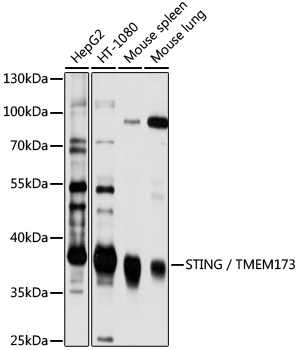Product Detail
Product NameSTING / TMEM173 Rabbit Polyclonal Antibody
Host SpeciesRabbit
ClonalityPolyclonal
IsotypeIgG
PurificationAffinity purification
ApplicationsWB,IF
Species ReactivityHuman,Mouse,Rat
Immunogen DescRecombinant fusion protein of human STING / TMEM173 (NP_938023.1).
ConjugateUnconjugated
Other NamesTMEM173;ERIS;MITA;MPYS;NET23;SAVI;STING;hMITA;hSTING
Accession NoSwiss Prot:Q86WV6
Gene ID:340061
Uniprot
Q86WV6
Gene ID
340061
Calculated MW42kDa
Sdspage MW37kDa/38kDa
FormulationBuffer: PBS with 0.02% sodium azide,50% glycerol,pH7.3.
StorageStore at -20˚C. Avoid freeze / thaw cycles.
Application Details
WB 1:500 - 1:2000
IF 1:50 - 1:200
Western blot analysis of extracts of various cell lines, using STING \ TMEM173 antibody.
Western blot analysis of extracts of various cell lines, using STING \ TMEM173 antibody.
Immunofluorescence analysis of L929 cells using STING \ TMEM173 antibody.
This gene encodes a five transmembrane protein that functions as a major regulator of the innate immune response to viral and bacterial infections. The encoded protein is a pattern recognition receptor that detects cytosolic nucleic acids and transmits signals that activate type I interferon responses. The encoded protein has also been shown to play a role in apoptotic signaling by associating with type II major histocompatibility complex. Mutations in this gene are the cause of infantile-onset STING-associated vasculopathy. Alternate splicing results in multiple transcript variants.
If you have published an article using product 54752, please notify us so that we can cite your literature.
et al,Nucleus-targeted ruthenium(II) complex triggers immunogenic cell death and sensitizes melanoma to anti-PD-1 therapy by activating cGAS-STING pathway.
, (2025),
PMID:
40022761





 15-30 working days
15-30 working days



